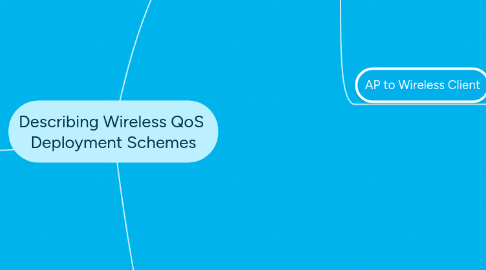
1. QoS in H-REAP
1.1. For WLAN's that have data traffic forwarded to the Controller, the behavior is same as regular local-mode APs.
1.2. For Locally-switched WLANs with WMM traffic, The AP marks the dot1p value in the dot1q VLAN tag for upstream traffic. For downstream traffic, the HREAP uses the incoming dot1q tag form the ethernet sideband uses this to queue and mark WMM values on the radio.
2. Downstream
2.1. Wired Client to WLC AP
2.1.1. Packets are encapsulated between WLC & APs, they have both inner and outer headers.
2.1.1.1. Inner Header
2.1.1.1.1. Contains the DCSP information received form the Wired Network.
2.1.1.2. Outer Header
2.1.1.2.1. Contains QoS information used by to Transfer the packet from the Controller to the AP and back.
2.1.2. When the Packet reaches the controller, the Original DCSP is read and kept in the inner DCSP field.
2.1.2.1. The packet is transformed into an 802.11 frame and encapsulated into CAPWAP
2.1.2.1.1. During the encapsulation process, the QoS value is read in the DSCP field and compared to the QoS value applied to the WLAN. Several Cases can occur:
2.2. AP to Wireless Client
2.2.1. If the AP is connected to access port of a Switch, keep the 802.11p tag is not possible, because access port doesn't accept tagged frames so, before sending the frame to the AP the access Switch removes the 802.1p tag, and the AP receives the frame with only the DCSP information on the outer header.
2.2.1.1. After the packet has arrived to the AP the inner packet is retrieved and distributed to the cell. Two cases can occur:
2.2.1.1.1. The client doesn't support WMM.
2.2.1.1.2. The client support WMM.
3. Upstream
3.1. Wireless Client to AP
3.1.1. The client cannot support WMM in which case no 802.11e field is set on the 802.11 frame.
3.1.2. If client support WMM the 802.11e field displays a Traffic Category. After the AP receives the 802.11 frame. Two cases can occur:
3.1.2.1. The Controller WLAN has no QoS Mapping
3.1.2.1.1. The frame is encapsulated and sent to the Controller without any QoS information in the outer header
3.1.2.2. The Controller WLAN has a QoS Mapping. The behavior depends on the client WMM support.
3.1.2.2.1. Clients doesn't support WMM. The AP tags the outer header with the QoS value mapped to the WLAN that is indicated by the Controller.
3.1.2.2.2. For Clients supporting WMM, the AP tags the outer header with the QoS value requested by the client, capped to the controller WLAN QoS Maximum.
3.2. AP to Controller
3.2.1. After the controller receives the frame, it retrieves the inner frame that contains the 802.11e and DSCP value Request by the client. The Controller convert the 802.11 frame into an 802.3 frame without altering the QoS request.
